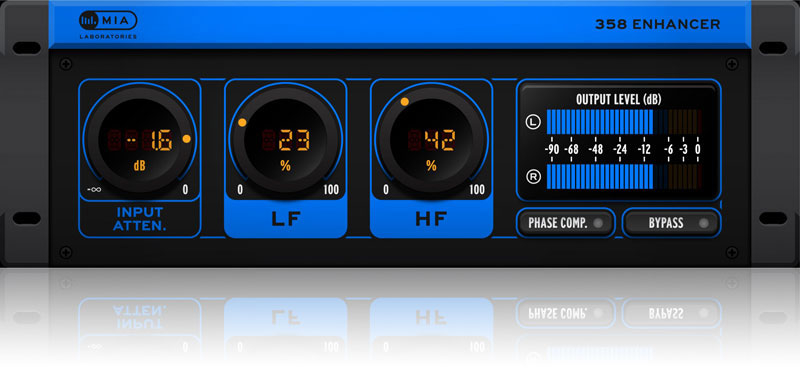You're currently on:
358 Enhancer
Control and Enhance your Bass and Treble
The 358 Enhancer is a single-stage, 'straight-path' process allowing control of the bass/treble frequency balance of a stereo mix or mono channel. It can be used in many applications requiring from slight to more drastic frequency balance correction, but unlike a conventional EQ or filter, the 358 uses internal multi-band phase processing.
This results in a more dynamic, realistic frequency content which is adjustable with two main controls for constructive (boost) process, folding at the classic 150Hz (LF) and 2.4KHz (HF) frequencies.
The internal process includes a detection stage based on the analog envelope detector circuit, first introduced in MIA's 925 Compressor.
In addition, the 'Phase-Compensation' mode (PHASE COMP. button) applies a fixed process to the whole bandwidth of the program material, for stereo image enhancement on two-channel mix or mix-buss applications. This 'phase-deviation' process has been developed carefully as a one-way stereo signal conditioning and enhancement, especially for sounds which are 'panned', or containing instrument-position information.
Improve your perceived sound-stage and definition of each source or instrument, without altering significantly the frequency or dynamic content of the processed audio.
This results in a more dynamic, realistic frequency content which is adjustable with two main controls for constructive (boost) process, folding at the classic 150Hz (LF) and 2.4KHz (HF) frequencies.
The internal process includes a detection stage based on the analog envelope detector circuit, first introduced in MIA's 925 Compressor.
In addition, the 'Phase-Compensation' mode (PHASE COMP. button) applies a fixed process to the whole bandwidth of the program material, for stereo image enhancement on two-channel mix or mix-buss applications. This 'phase-deviation' process has been developed carefully as a one-way stereo signal conditioning and enhancement, especially for sounds which are 'panned', or containing instrument-position information.
Improve your perceived sound-stage and definition of each source or instrument, without altering significantly the frequency or dynamic content of the processed audio.
| Variant | 1 |










